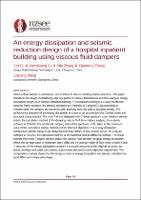An energy dissipation and seismic reduction design of a hospital inpatient building using viscous fluid dampers

Download
Date
2024-04-09Authors
Li, Lei
Ge, Haoshuang
Zhang, Min
Zhang, Xiaomeng
Wang, Dayang
Metadata
Show full item recordAbstract
Viscous fluid damper is commonly used in China to reduce building seismic response. This paper introduces the design methodology and key-points of viscous fluid damper in China using an energy dissipation design of an hospital inpatient building. The inpatient building is a 4-story reinforced concrete frame structure, the seismic precautionary intensity is 7 degree(0.10g) according to Chinese code, the dampers are connected with beam by concrete wall to dissipate energy. The performance objective of the energy dissipation structure is set according to the Chinese codes and structural characteristics. The main frame is designed with Chinese spectrum under medium seismic action, the calculation method of the damping ratio is FNA time-history analysis, the analysis software is ETABS. The additional damping ratio of the spectrum is 5%, taken as the minimum value of the cumulative energy method and the standard algorithm. The energy-dissipation substructure and the dampers are designed with time history of rare seismic action, the analysis software is SAUSG, the calculation method is the modified central difference method. The result indicate that under 7 degree seismic action, the viscous fluid damper has good energy dissipation effect, the average value of maximum story drifts and the average value of floor shear in both X and Y direction of the energy dissipation structure is reduced compared to the original structure, the plastic development under rare seismic action meets the performance objective requirement. The comparative analysis shows that the design scheme of energy dissipation and seismic reduction has good effect and unique advantages.
